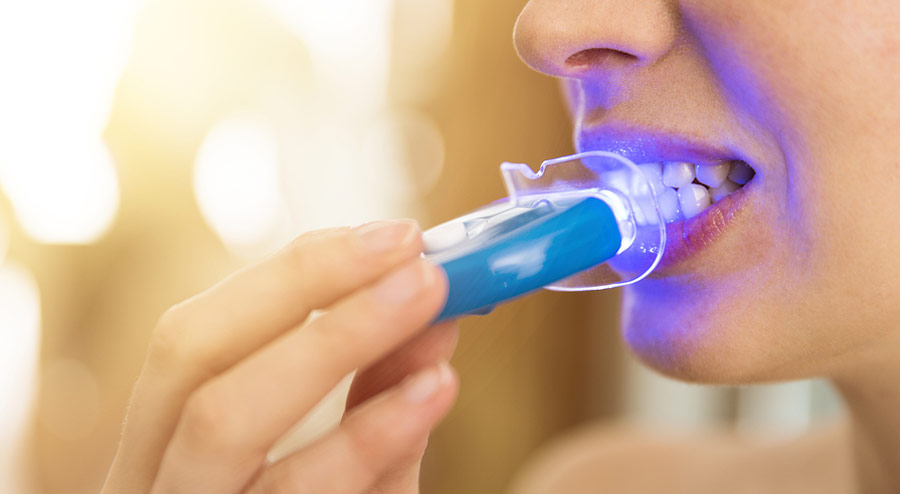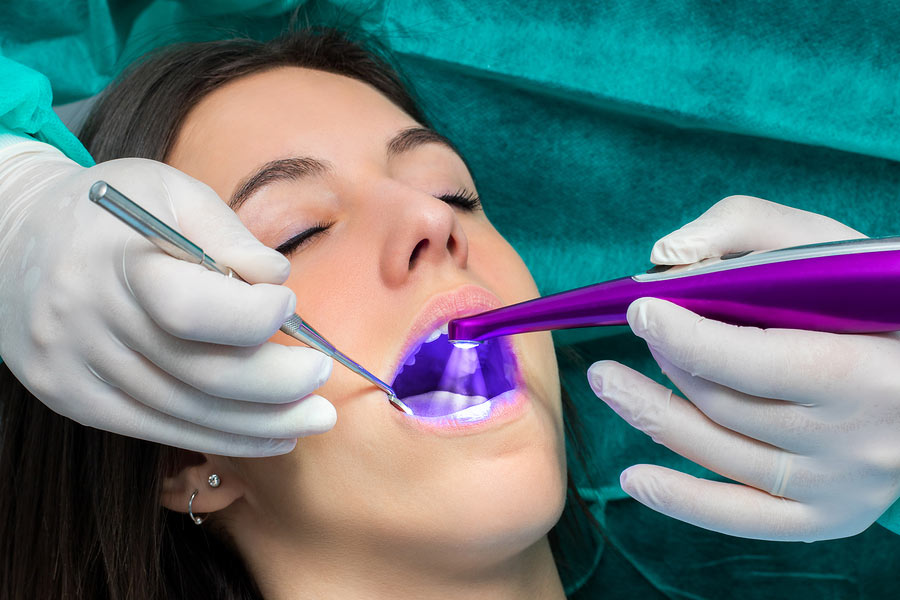Using a Blue Whitening Light for Gum Diseade

Underneath the enamel, we have another layer to our teeth called dentin. This transfers sensation from the enamel to the inner pulp and nerve. Dentin is naturally a yellow color and can darken with age. If the enamel on your teeth erodes and thins, then the yellow from within your teeth can start to show through and give the teeth a darkened and stained appearance. This intrinsic discoloration is much more difficult to deal with.
Since so many people want whiter smiles these days, there are plenty of methods to try that promise to produce some lightening effect, such as tooth whitening gel. Just about every brand of toothpaste and mouthwash has a whitening version that mixes in additions like baking soda to scrub away surface staining or hydrogen peroxide to penetrate and lift deeper staining over time. Whitening strips and professional procedures use bleaches like carbamide peroxide to battle both extrinsic and intrinsic staining.
Unlike tooth whitening gel, bleaches tend to be the quickest and most effective way to lighten the color of teeth. This is because instead of simply addressing surface staining, bleach can also penetrate to address the internal color of the teeth. The bleach works to alter the internal tooth color through a chemical and physical reaction. Basically, the bleach opens pores in the tooth enamel to allow the agent to seep through to get to the dentin. At the internal dentin layer, the bleach's oxygen molecules work to lift the discolored molecules from the dentin base, leaving the natural color behind. It is very similar to the mechanics behind how hydrogen peroxide is able to kill bacteria.
Using bleach on your teeth as whitening treatment will dehydrate the tooth and increase sensitivity. The sensitivity is caused both by the dehydration of the tooth and also due to the pores of the enamel being exposed. The dentin which is the target of this intrinsic whitening process is the layer of the tooth that transmits sensation to the nerve. Therefore, if there is a direct line to the dentin, sensations are amplified. The longer the product is left on the teeth the worse it gets, which is why it is advantageous to increase the rate at which the whitening chemical reaction is taking place.
The way that dentists have found to speed up this chemical whitening process is by using blue light. The blue light acts as a catalyst to increase the rate at which the chemical reaction occurs. This either allows the session to be shortened or for improved results in the same amount of time. If you have never had your teeth whitened with strong bleach before, then it would be best to have this done the first time in a dentist's office. They can monitor the progress and effects on your teeth to ensure no damage is done.

The use of UV light in the oral application has been replaced by LED lights. Blue spectrum visible LED light has also been proven to provide a catalytic effect for chemical reactions without the added risk of radiation. LEDs have a few benefits over UV lights beside the fact that they are not carcinogenic. They can be much more intense and bright without creating heat at the same time. They also do not require a great deal of power and have long lives. Just like their UV counterparts, blue LED light alone does not change the color of the teeth. It must be used in conjunction with a hydrogen peroxide or carbamide peroxide bleaching solution.
While blue light aided teeth whitening used to only be a service offered in a professional office, there are now home kits that incorporate this catalyst device. A home whitening kit will never be as strong as what you can find in a dentist's office. This is mostly to protect the patient from themselves. It can be very tempting to cut corners on the directions or to try to use the product longer or more frequently than directed. Failure to follow the product directions has serious risks, so it is best that professional grade products are not sold for home use. You should still be able to get several shades lighter at home with a blue light kit.
When using a blue light whitening kit, you will first want to protect your gums with a petroleum jelly substance, especially if they are sensitive. Then you will apply the gel as directed and direct the light to your bleach covered teeth for the duration of the application. As LED light is very strong you should never look directly at it. Do not leave the bleach on for longer than directed and do not use more frequently than advised.
After following the whitening process your teeth will be sensitive. Avoid overly hot or cold food and beverages for a few days and do not consume anything that can be staining. Your teeth will be especially susceptible to sensation and staining until the pores can shrink back down. Keep in mind that there is no such thing as a permanent whitening method, and even blue light whitening loses its potency the longer you use it. Practice good oral care and avoid substances that can stain your teeth or erode your enamel.
"The research doesn't clearly support the value of light to whiten teeth. But it's a relatively simple addition, and it's fairly economical to try."
Dr. Greg Grillo
Source: https://www.emergencydentistsusa.com/blue-light-teeth-whitening/
0 Response to "Using a Blue Whitening Light for Gum Diseade"
Post a Comment